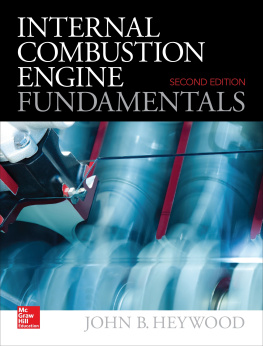John B. Heywood - Internal Combustion Engine Fundamentals
Here you can read online John B. Heywood - Internal Combustion Engine Fundamentals full text of the book (entire story) in english for free. Download pdf and epub, get meaning, cover and reviews about this ebook. year: 2018, publisher: McGraw-Hill Education, genre: Science. Description of the work, (preface) as well as reviews are available. Best literature library LitArk.com created for fans of good reading and offers a wide selection of genres:
Romance novel
Science fiction
Adventure
Detective
Science
History
Home and family
Prose
Art
Politics
Computer
Non-fiction
Religion
Business
Children
Humor
Choose a favorite category and find really read worthwhile books. Enjoy immersion in the world of imagination, feel the emotions of the characters or learn something new for yourself, make an fascinating discovery.
- Book:Internal Combustion Engine Fundamentals
- Author:
- Publisher:McGraw-Hill Education
- Genre:
- Year:2018
- Rating:4 / 5
- Favourites:Add to favourites
- Your mark:
Internal Combustion Engine Fundamentals: summary, description and annotation
We offer to read an annotation, description, summary or preface (depends on what the author of the book "Internal Combustion Engine Fundamentals" wrote himself). If you haven't found the necessary information about the book — write in the comments, we will try to find it.
The long-awaited revision of the most respected resource on Internal Combustion Engines --covering the basics through advanced operation of spark-ignition and diesel engines.
Written by one of the most recognized and highly regarded names in internal combustion engines this trusted educational resource and professional reference covers the key physical and chemical processes that govern internal combustion engine operation and design.Internal Combustion Engine Fundamentals, Second Edition,has been thoroughly revised to cover recent advances, including performance enhancement, efficiency improvements, and emission reduction technologies. Highly illustrated and cross referenced, the book includes discussions of these engines environmental impacts and requirements. You will get complete explanations of spark-ignition and compression-ignition (diesel) engine operating characteristics as well as of engine flow and combustion phenomena and fuel requirements.
Coverage includes:
- Engine types and their operation
- Engine design and operating parameters
- Thermochemistry of fuel-air mixtures
- Properties of working fluids
- Ideal models of engine cycles
- Gas exchange processes
- Mixture preparation in spark-ignition engines
- Charge motion within the cylinder
- Combustion in spark-ignition engines
- Combustion in compression-ignition engines
- Pollutant formation and control
- Engine heat transfer
- Engine friction and lubrication
- Modeling real engine flow and combustion processes
- Engine operating characteristics
John B. Heywood: author's other books
Who wrote Internal Combustion Engine Fundamentals? Find out the surname, the name of the author of the book and a list of all author's works by series.










